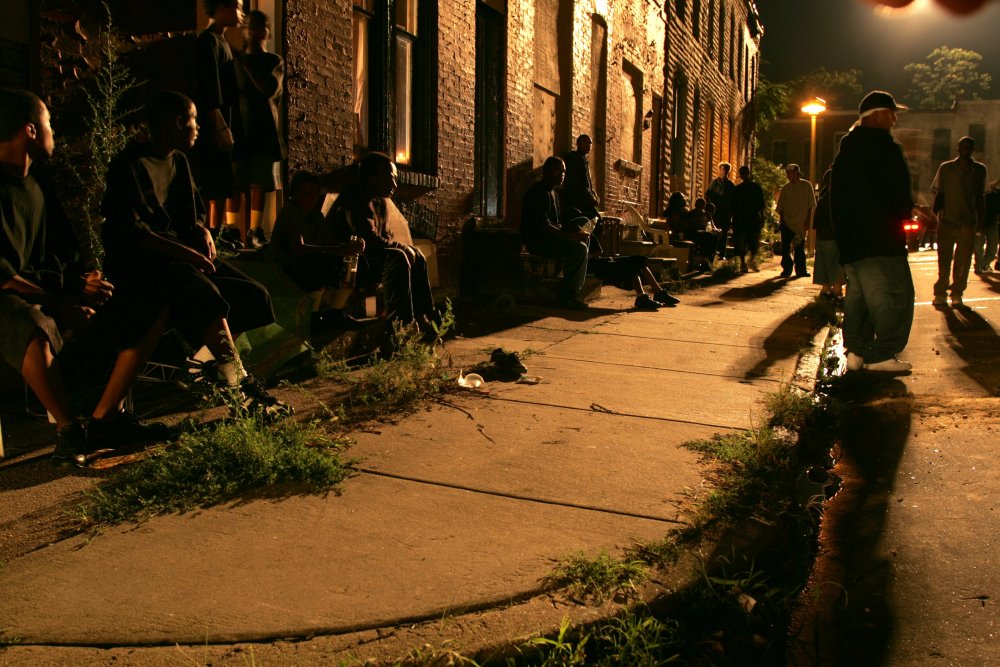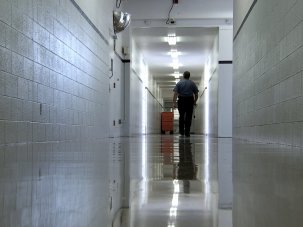“I feel that today filmmakers who make films that have social significance… make metaphors. They say: ‘It’s a western but it’s really about Vietnam’ or ‘It’s a gangster story but it’s really about the difficulty of speaking the truth in America,’ etc. In other words, they make substitute pictures.”
Elia Kazan made this observation to Michel Ciment in 1973, and it’s just as true 35 years later. Perhaps the situation is even worse. American viewers, filmmakers and critics are still used to looking at our social world through generic constructs, codes and structures. There’s nothing inherently wrong with genres or metaphors, but our reflexive expectation of them as a frame around contemporary reality is dispiriting, and it points to a national tendency that originates outside cinema. Any American with a decent standard of living – and that includes our filmmakers – has internalised a consistently reiterated imperative that’s hard to shake: whenever you confront the national reality, don’t forget about the national dream. How else could we have seen an entire era of factory closings virtually ignored by the cinema, with the exceptions of a lousy Ron Howard comedy (Gung Ho), a piddling faux-documentary (Dadetown) and a vastly overvalued comedy skit in the guise of a fearless exposé (Roger & Me)?
And then, suddenly, HBO came to the rescue. The Wire, a critics’ darling since its inaugural season in 2002, more or less lives up to its hype as the greatest thing to hit television since The Honeymooners. For most of its near 60-hour duration, this cross-hatched portrait of the drug economy in Baltimore, Maryland, plausibly unfolds as one ongoing work as opposed to the usual theme and variations. Not that it isn’t a struggle. There are many moments when you can feel chief writer David Simon and his cohorts almost giving in to the pull of the usual.
They come close, particularly in the severely flawed final episodes, but they never go all the way. It takes nerves of steel and the heart of a know-it-all to bypass American Dream-iness when you’re making a TV series, and Simon & Company have both. Early on, you can sense that the creative team is buoyed by the certainty that they’ve got there first and opened up some perilous, racially charged terrain: a just depiction of underclass life in a failing American city. More than most TV series or films, The Wire is very much a group creation, of writers (including Richard Price and Dennis Lehane), directors, technicians and, especially, actors. Just like the ‘cuff artists’ from Warner Bros who honed in on the rhythm of urban life in the early sound era, the actors together find the right emotional tones, speech patterns, styles of exchange and power relations for their believably varied citizenry.
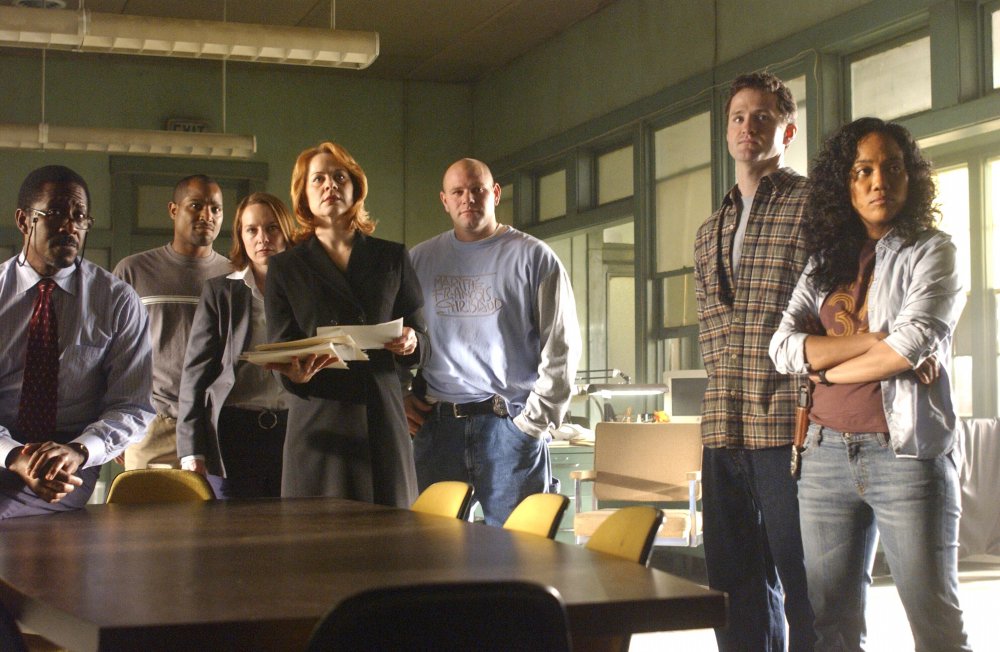
The Wire’s investigating detail, and colleagues; from left: Lester Freamon (Clarke Peters), Ellis Carver (Seth Gilliam), Beadie Russell (Amy Ryan), Felicia ‘Snoop’ Pearson (Felicia Pearson), Thomas ‘Herc’ Hauk (Domenick Lombardozzi), Roland ‘Prez’ Pryzbylewski (Kim True-Frost), Kima Greggs (Sonja Sohn)
This joy of collective discovery accounts for The Wire’s considerable quotient of uplift – we’re watching actual characters, rather than agglomerations of behavioural and fashion cues, walking through real places as opposed to vague approximations and responding to believable situations instead of artfully contrived set-ups. It helps to offset the relentlessly downbeat thrust of the show. Watching too many episodes in a row can be a depressing experience, and it must be said that this points to a limitation. Given the amount of territory covered (spatial, psychological, social, spiritual), The Wire appears to be a much less single-minded enterprise than it is. From beginning to end, Simon and his collaborators maintain an entirely coherent and consistent opposition to unchecked capitalism. But their insistence on survival of the fittest, every character either thinking six moves ahead of the game or measuring his or her own grave, becomes constricting by season three. It’s almost (but not quite) counterbalanced by the many unexpected moments of regeneration and renewal, an unusually sharp sense of the good in the unlikeliest of characters.
Yet shortcomings and all, The Wire is some kind of major achievement. To paraphrase Frank Kermode’s lovely observation on Hamlet, the richness and complexity of the show stands as a tribute to the intelligence of its audience.
“The first breakthrough into working-class life came through gangster films,” qualifies Kazan in Ciment’s book of interviews. “They were the first view from underneath.” In a broad sense, The Wire follows the outline of the gangster picture with its eternal themes of avariciousness, betrayal and overreaching. What lifts the show away from generic trappings is the care with which these themes are woven into the life of a city at every level: everyone thinks like a gangster. In the majority of mob movies there is a reassuring barrier between the underworld and Our World.
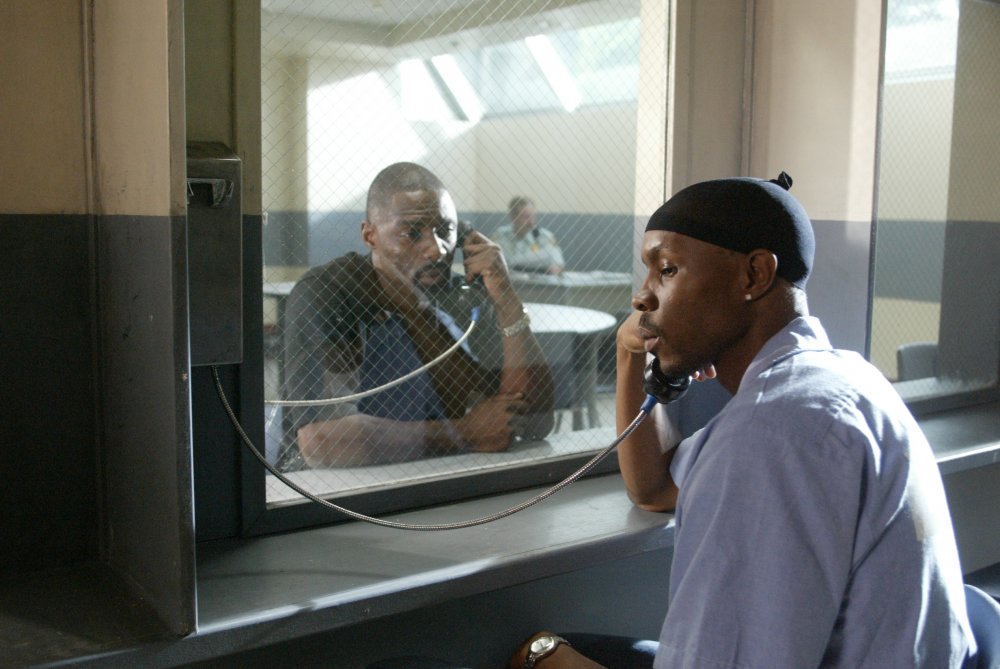
Avon Barksdale (Wood Harris, right) is visited in jail by his second-in-command Stringer Bell (Idris Elba)
But Simon understands that this dividing line is a fantasy. Here the social fabric encompasses everything from the corner to the classroom, the mayor’s office to the titty bar, the union hall to the funeral parlour. The junkie is as wise as the police major, the state senator as much in need of redemption as the stash lookout.
This is not just an affair of simple cross-cutting. There are no rhyming arias of despair as in Crash or Babel. Not a single character is short-changed. Of course it is partly a matter of duration – there’s a lot more room for character development in 60 hours than in two – but it’s also a matter of extraordinary care, a colossal effort to get every character and every power relationship right, and it’s born of the burning, righteous anger of the show’s creators.
Simon & Co. skip the usual brothers-under-the-skin number because they know that in the world of capitalism unbound, ruthless self-preservation will always trump peace, love and understanding. The urgency of the situation – a broken social system that all but guarantees numerous lives lived in abjection or murderous disengagement – demands that every character be listened to, respected, befriended. No one gets their just desserts, no one is discarded. A few episodes into this colour-blind show you’ll understand that nothing but the moral luck of the draw separates us from the homeless addict Bubs, or Namond, the teenager with no heart for the game. On The Wire there really is no such thing as ‘them’. There is only us.
Life of a city
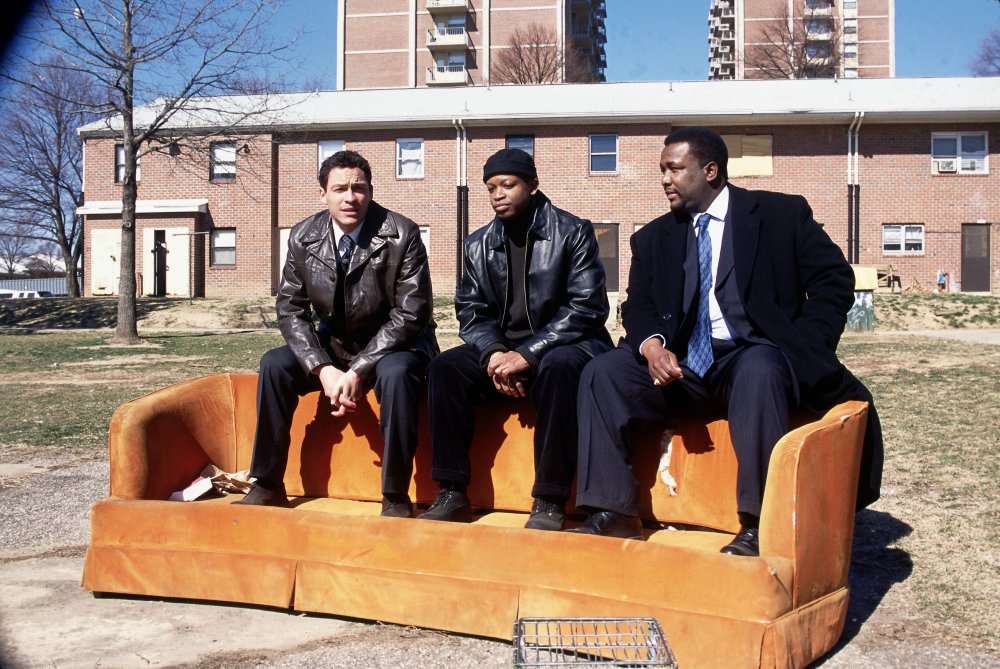
Detectives McNulty (Dominic West, left) and Bunk (Wendell Pierce, right) with dealer D’Angelo Barksdale (Larry Gilliard Jr.) in season one
From Blackboard Jungle through Clockers, a major stumbling block in films that attack social ills is keeping the characters pliable, steering them out of grey patches of inclement significance. So it’s a revivifying experience to encounter a character like D’Angelo Barksdale, played with a winning and tactful subtlety by Larry Gilliard Jr. Clean cut and bright eyed, he contemplates the future from a beat-up couch in the open court of a decrepit housing project, supervising the sale of heroin to the local population. As we come to know him, we begin to sense a concealed strain of sensitivity and a hint of worry. He’s the nephew of kingpin Avon Barksdale, placed in a prime spot out of family loyalty, but he is being watched as much as groomed and the unease we detect doesn’t go unnoticed by his uncle and second-in-command Stringer Bell.
If you follow the progress of D’Angelo through the all-but-flawless first season to his lonely death in a prison library in the middle of the second, you’ll find a perfect illustration of what makes The Wire so special. First of all, there’s the familiarity between D’Angelo and his network of friends, co-workers, superiors and law-enforcement antagonists, a shared language and social structure into which we’re dropped without any introductory set-up. We also quickly come to understand ‘slinging’ as something other than the usual descending blight. In The Wire the drug trade really is a trade and entry level begins in pre-adolescence.
With that we come to a more painful understanding: for the kids in west Baltimore, life expectancy is short. This is articulated four seasons in by a mid-level dealer named Bodie, who appears to be peripheral to The Wire but who actually sits at its moral centre (he’s played with exquisite heart and perfect instincts by a rock-solid young actor named J.D. Williams). “I feel old,” he admits, and at the age of 25 he’s simply seen too much to believe in his own continuing survival. He’s saying out loud what we’ve inferred from the beginning: in the smooth baby face of D’Angelo as he looks a little too intently into the horizon, in the lethargic despair of a sweet-faced young boy named Wallace, in the shifts between bravado, cold calculation and brooding silence on the face of Avon.
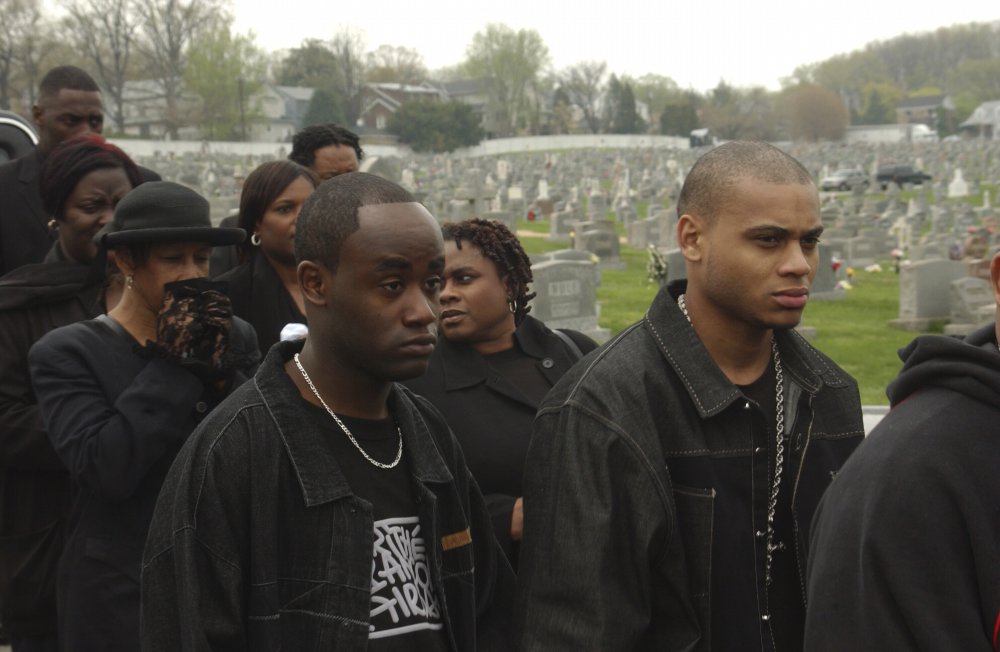
Poot (Tray Chaney) and Bodie (J.D. Williams) at a friend’s funeral
These values are imparted slowly and incrementally, with an ingenious storytelling method that elbows its way in and out of narrative lines, picking up characters and threads at unexpected moments. Though it becomes too systematic at times, this is a fiendishly clever way to cover the life of a city. It echoes the sensation of overabundance that comes with actual city living and also reinforces an aura of inevitability, embodied perfectly in the becalmed visual style of DP Uta Briesewitz (her departure in the middle of the third season was a loss, but her template remains throughout: a patiently observant camera eye that tends to retreat to long and wide views, eager to nail character and environment).
The net effect is to draw us away from the drama of a police investigation and to create a portrait of a city in crisis block by block, brick by brick. We’re allowed time to concentrate on little pockets of behaviour, light, movement, geography, to get the feel of an idle afternoon in the courtyard of a housing project, the unkempt vivacity around a basketball grudge match between rival neighbourhoods, or the quiet cleanliness of a murder scene months after the fact.
Finally, someone has put the duration afforded by television to good use, with a genuine respect for randomness, the cyclical and serial delusions of humanity (in a recurring motif, a character will suddenly believe that he or she has gamed the system, only to be sent crashing back to earth by bad luck or poor timing). That “raw, unencumbered capitalism,” to quote Simon, is the real enemy; that the drug trade is only its most visible and destructive manifestation; that the ‘war on drugs’ is nothing more than an ultimately ineffective form of social control – these points are allowed to sink in slowly, with an ease that is beyond the means of a two-hour movie. Parallels between overworked detectives and downtrodden corner kids, between police brass and the drug bosses, are generated carefully and without rhetorical sweat. The overall structure has so much tensile strength that it also carries the lapses incurred by Simon & Co. as they struggle their way towards a balance between absorbing entertainment and an accurate accounting of life in the ‘post-industrial age’.
Ghost story in progress
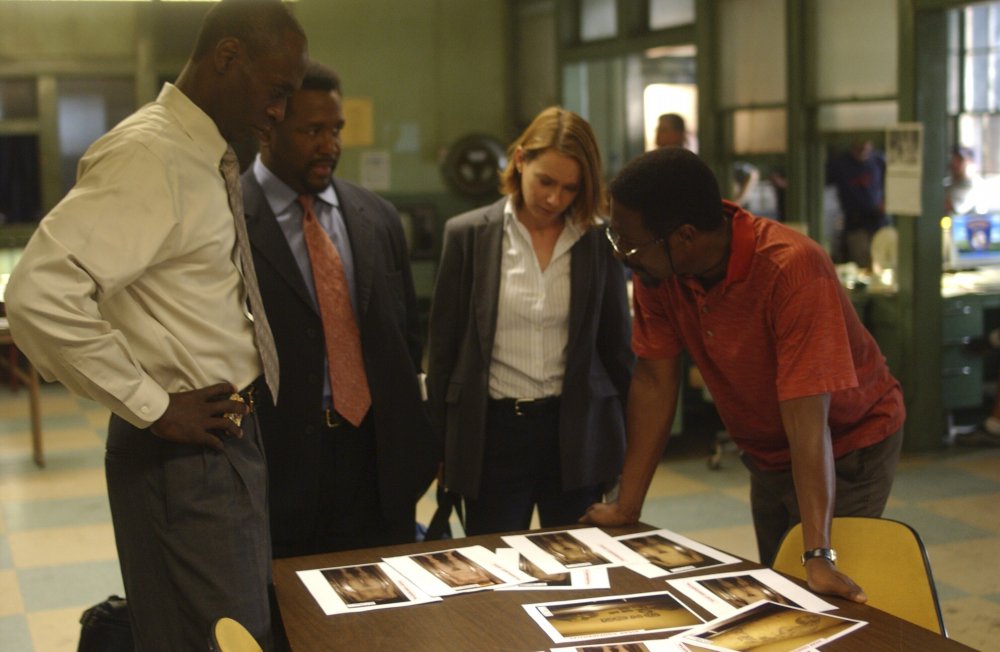
Lieutenant Cedric Daniels (Lance Reddick) with Bunk, Beadie Russell and Lester Freamon in season two
Most of the acting on The Wire is unusually good, though there’s a broad spectrum of talent, style and creative intelligence. Dominic West is a little too sunny for the maniacally obsessive detective he’s playing, but his ebullience makes a good fit with McNulty’s contrite side and with his cockiness. Aidan Gillen leans into the voracious politician Tommy Carcetti like a mariner heading into a gale, an all-forward-movement performance, while Clarke Peters’ detective Lester Freamon is a sedentary piece of winningly hambone stoicism. Clark Johnson does some nicely textured work as the Sun’s city editor, injecting little bursts of invective into his character’s relaxed surface, while Wendell Pierce’s detective Bunk is the kind of authoritative character performance one used to see on a routine basis from Vincent Gardenia or Yaphet Kotto.
Sometimes the actors enliven the characters, as with Seth Gilliam as the street cop Carver, a fascinating actor who shifts between states of tension and occasionally swan-dives into soliloquies of paternalistic authority before the corner kids, or Amy Ryan, who shades an unusual amount of emotion into her quietly grounded port cop. Sometimes the writing carries the actor, as with Glynn Turman, who heaps too much bullshit all over his Mayor Royce, or Sonja Sohn as detective Kima Greggs, a genuinely monotonous actor who tries to make her limited repertoire of head-bobbing exasperation and hip-hugging indignation suit every situation.
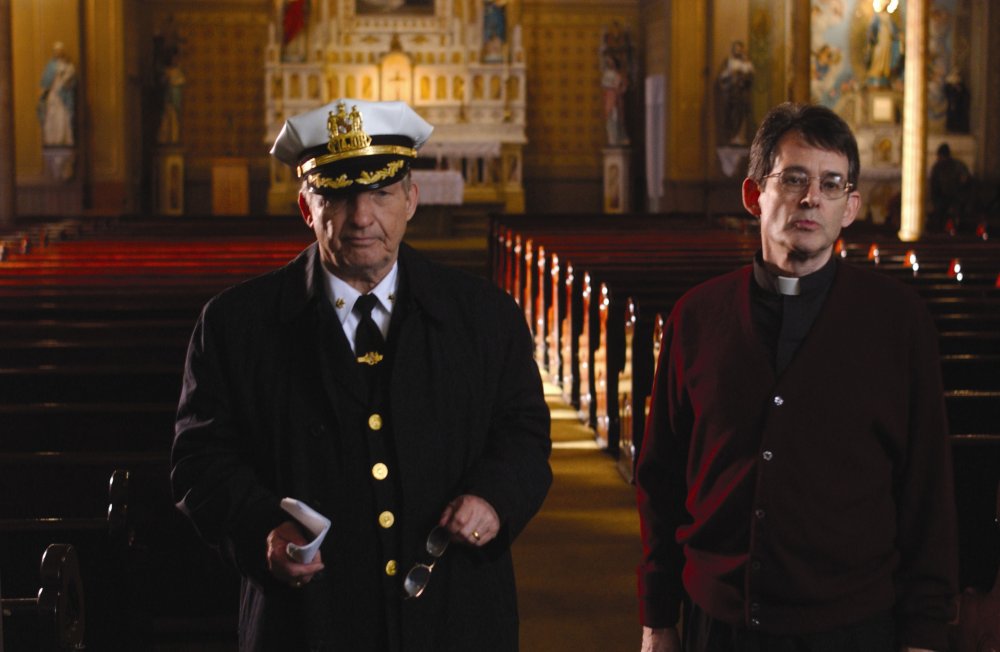
Major Stanislaus Valchek (Al Brown) and a priest
Each of these characters would be fodder for a superior cop show, but they become truly interesting when placed within The Wire’s vast social web and in the context of the depiction of police work as blue-collar drudgery – one episode ends with an entire investigative unit racing to type up a mountain of paperwork in order to meet a deadline for a search warrant. Only John Doman’s ‘Deputy Ops’ Bill Rawls, Robert Wisdom’s Major Bunny Colvin and Al Brown’s Stan Valchek stand out as wholly original creations. Lance Reddick’s Lieutenant Cedric Daniels is also quite captivating, a striver with a couple of skeletons in his closet who rises to the top on the strength of his police work alone. Reddick’s effort to maintain a stiff-backed dignity can be very touching but I wish he had a few more arrows in his quiver: every other word comes out with a whoosh, as if shot from a catapult.
The Wire only comes fully alive when it’s on the wrong side of the law. In a sense you could say that there are no gangsters in the series, only people who sell drugs, steal drugs, or kill for a living. And death seems as natural as breathing. The hoppers working for Barksdale, Proposition Joe and Marlo all have a keen knowledge of their own expendability within the crew and the world at large, and this is what gives The Wire its eerie undertone. At a certain point we understand that we’re watching a ghost story in progress.
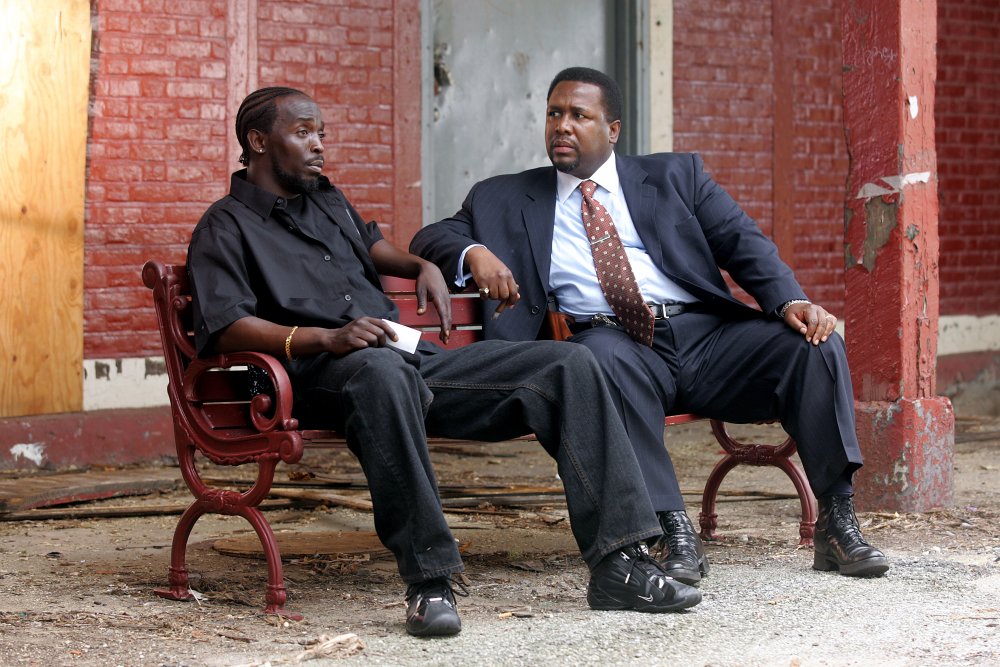
Stash thief Omar (Michael K. Williams) with Bunk
And we start to see the signs. Sometimes it’s in a character’s face – for instance, the hollowed-out, fine-boned face, decorated with a diagonal scar, of cunning stash thief Omar, played by a limited but game young actor named Michael K. Williams with boyish petulance, feline grace and genuine humility. Sometimes it’s in a character’s hubris, as with Idris Elba’s Stringer Bell, who like McNulty suffers from the mistaken belief that he can play everyone against each other and come out on top.
Sometimes it’s in a character’s vigilance: Wood Harris’s Avon seems to have a third eye on the reaper and is ready to slaughter 20 innocent people to keep him at bay (Elba’s muscled heartthrob is an elegant piece of acting, but Harris’ may be the most exciting and subtly tuned performance in the series). Sometimes it’s in the dark cloud of bad luck hanging over a character, like Chris Bauer’s union boss Frank Sobotka, whose efforts to keep his port alive actually seal its destruction.
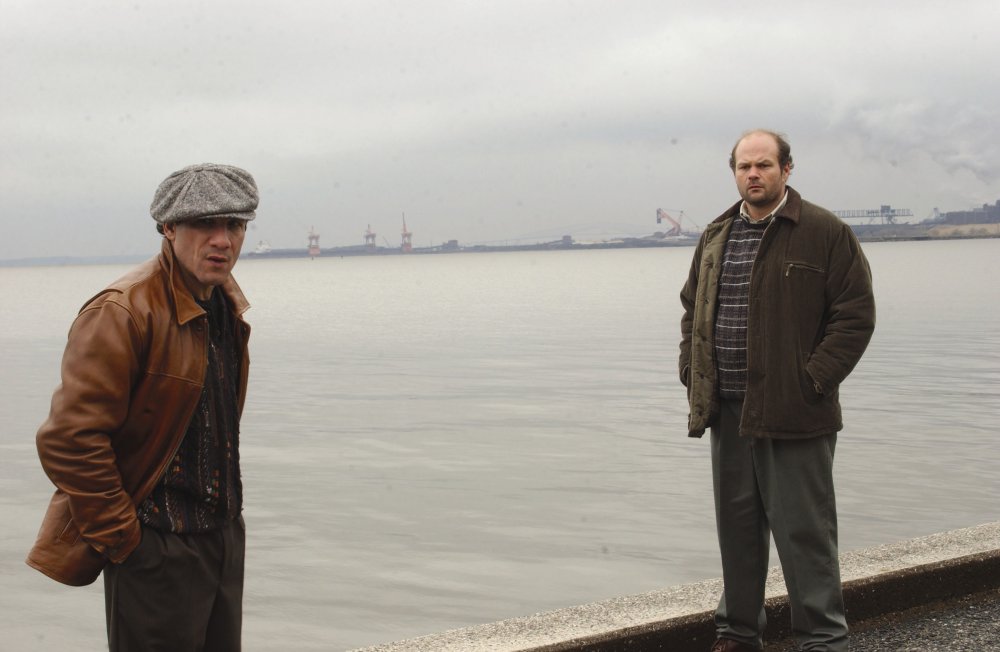
Dealer Spiros ‘Vondas’ Vondopoulos (Paul Ben-Victor) with union leader Frank Sobotka (Chris Bauer) in season two
Sometimes it’s simply present in a character’s affect, like Felicia Pearson’s Snoop, a pint-sized, muscled, drop-lidded ambisexual sprite. Like many of the other performers, Pearson grew up in Baltimore. She’s the child of drug addicts and after she went through the foster-home system she did jail time for a second-degree murder rap. She brings values to her hired gun that a trained actor couldn’t find with a map: it’s not the semi-comprehensible drawl or the near-subliminal yelps that she occasionally uses to announce herself, but the lumbering ease with which she walks through the twilight world of “Bodymore, Murdaland”, as if she’d already met her maker.
Undertone becomes overtone in the heartbreaking fourth season. The Wire is at its absolute best when it deals with children and teenagers, and there are few passages in recent cinema as shattering as the interchanges between the westside kids Randy (Maestro Harrell), Namond (Julito McCullum), DuQuan (Jermaine Crawford) and Michael (Tristan Wilds). They try to conjure up some childhood magic by telling each other ghost stories about the neighbourhood disappeared as zombified junkies trundle down the street; they steel themselves for another day of chaos in the classroom, another night at home with their addicted parents; they dare each other to break into a vacant building and commune with a body decaying under a layer of quicklime.

Namond (Julito McCullum), Michael (Tristan Wilds) and Randy (Maestro Harrell), in the foreground, are the focus of season four
The care taken by the filmmakers with the process of a soul’s coarsening unexpectedly moves The Wire into the emotional territory of Mouchette or The Devil, Probably. When Michael finally turns on Namond and beats him to a pulp, we’re witnessing much more than an explosion of adolescent anger: we’re confronted with two characters at a spiritual crossroads, one moving into abasement, the other into regeneration.
While there’s certainly more to say dramatically, The Wire reaches the filigreed end of its most crucial thematic strand with season four. The damnation of three boys and the salvation of one loops back to the harrowing murder of Wallace, the sweet 12-year-old who can no longer be trusted by Avon and Stringer, near the end of season one. As he sheds tears and wets his pants, his dutifully remorseless killers Bodie and Poot are embarrassed for him. Bodie delivers an unforgettable admonition: “Take it like a man.” This is the heart of The Wire – the memorialisation of an army of young men and women for whom death itself is a rite of passage.

Street cop Carver works with reformed dealer Dennis (Chad L. Coleman) to try to help kids like Namond find a way out
Recovery and regeneration
The Wire’s five seasons are quite distinct and variable. Season one is still the freshest and most exciting because all the characters and situations are new both to us and to the filmmakers and there’s no chance to indulge in comfy familiarities like McNulty and Bunk’s barside philosophising.
Season two, set in the world of the ports with their enormous cranes and stacks of varicoloured containers, is devastating, particularly for those of us who grew up in one of the many American cities eviscerated by corporate pullouts.
A little cushy repetitiveness begins to set in around season three, and the dramatic hook is Simon at his most polemical: Colvin, months from retirement and sick of telling his officers to up their arrest quotients so he can “juke his stats”, creates a free zone away from the neighbourhoods where drug dealers can operate with impunity. It’s intriguing, but it plays as if Simon wanted to create a realistic simulation to submit to city governments across America.
Season four, split between the classroom, the street and the office of newly elected and severely compromised Mayor Carcetti, is an unqualified triumph.
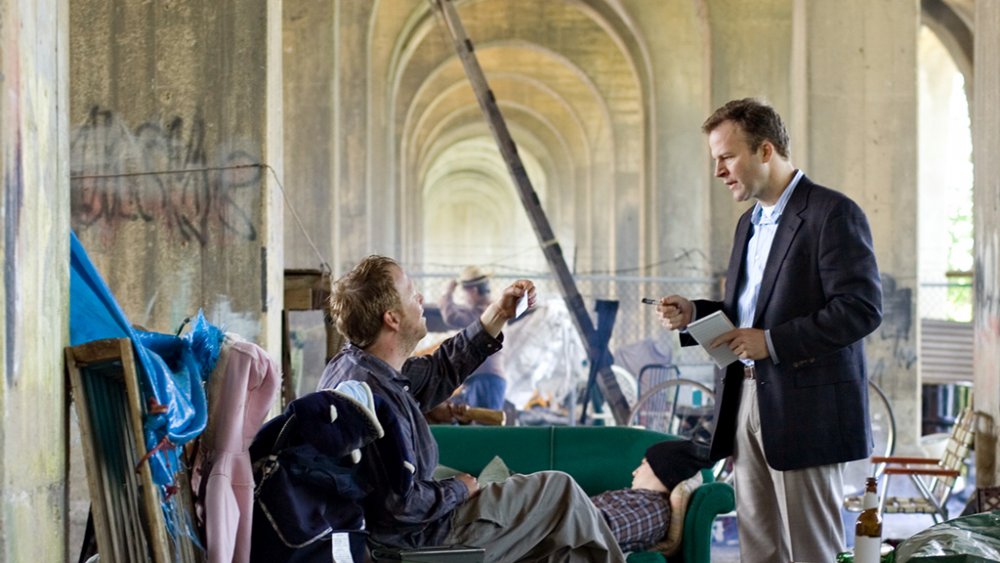
Tom McCarthy as ambitious newspaper reporter Scott Templeton in season five of The Wire
But season five is a problem. It’s far from bad, but at a certain point it devolves into something from which The Wire had previously managed to steer clear: good TV. McNulty plays out a scenario that’s breathtakingly preposterous – where the creators of The Wire had laboured for so many years to illuminate the ordinary, they suddenly lay down a whopper that’s about as implausible as an old Starsky and Hutch plotline. The Baltimore Sun focus is well handled, particularly in its treatment of the editorial process, but the milieu and the situation (an eager-beaver reporter who fabricates details and is prized by his effete editors) are way too familiar.
The writers might have gone in about 20 directions more interesting than this one (social services, big-time real estate, service industries), but it appears that Simon’s animus toward his old paper got the better of him. On top of which there are only ten episodes to work with rather than 12 or 13, so events become far more compressed than ever before. The wrap-up to this remarkable series is rushed where it should have been leisurely, disappointingly fractured as opposed to disturbingly unresolved, nervously eager to please rather than majestically sombre.
There is, however, a remarkable ending to one plot strand: the recovery and regeneration of Bubs. The dramatic arc of this character and André Royo’s near-perfect performance (I’ve never seen an actor bring a lighter touch to drug addiction) add up to the finest representation of a junkie’s progress I know of.
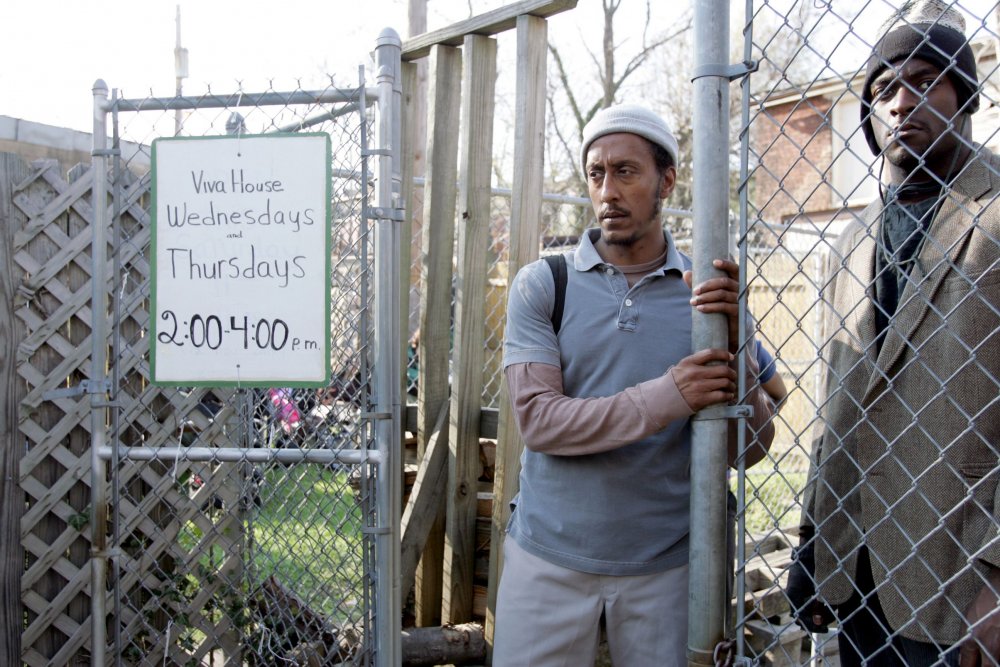
André Royo as Bubs in season five
Adding new dramatic wrinkles to the lives of McNulty, Greggs and Daniels is obviously a nod to the fans and a duty to HBO, but it shifts the focus to the characters and away from the city. Of course, what I see as the show’s strengths may not jibe precisely with Simon’s vision. Simon’s truth is essentially a journalist’s truth and I think it’s journalistic dedication and devotion that drive him. Which is to say that he seems to think in terms of topics and arguments first, spiritual destruction and regeneration second. But who cares? What difference does it make that the power of The Wire is more a matter of concentration, intensity of focus and momentum than mise en scène and poetic precision?
The tragedy of modern cinema lies in the same devaluation of work that the show chronicles so eloquently in the second season. The cinema is now filled with corporate-driven spectacles and auteur-driven creations, and in both cases there’s a strong whiff of alienated labour, an assortment of technicians performing their roles from their assigned cubicles and going home for the night. Not since the days of the studio system have we seen such a winningly collective endeavour, where the impresario is less demiurge than facilitator, the “court of last resort” as Simon has put it.
What I admire most about the show, though, is its Dostoevskyan spirit of radical forgiveness. Every character is allowed to maintain his or her humanity, no one is turned away from the possibility of redemption. This is a rarity in cinema and a virtual impossibility in television, and it’s what lifts The Wire into the realm of greatness.
-
The Digital Edition and Archive quick link
Log in here to your digital edition and archive subscription, take a look at the packages on offer and buy a subscription.




